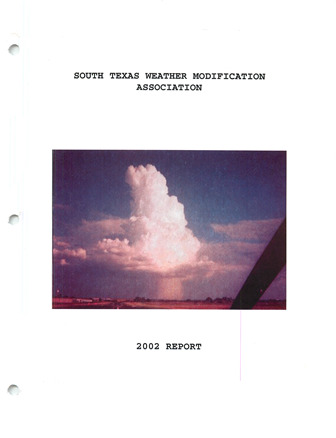South Texas Weather Modification Association 2002 Report

| Summary |
|
STWMA entered year number six in operations in 2002. With a fresh new radar office in place, we eagerly awaited the first day of seedable weather. It wasn’t until mid-April before this took place, but what a start: intense thunderstorms developing right over the radar site, prompting warnings by the NWS. Some seeding of this activity took place, and with that, we were well on our way to what would hopefully be a busy year of rainfall enhancement. We welcomed two pilots to the association in the spring. Ron Merks, who worked with the program back in 1997-98 when AI was running operations, joined us once again in 2002. In addition, Mickey Chadwell, a flight instructor at Stinson Field, trained with us this year to become STWMA’s fifth and newest pilot. With the additional pilots, there came another Comanche. N57AA, also referred to as “Strawberry Five” or “Lipstick Queen” due to its iridescent pink paint, was purchased in the spring and became operational in June. With the departure of WMI from the EAA Weather Modification project, seeding to our north was halted by the end of 2001. The EAA, however, was still interested in having a weather modification program in some of the counties. Working with the STWMA and the SWTREA (Cotulla) programs, they developed a contract whereupon the STWMA would annex the counties of Bandera, Bexar and Medina into the target area for the May-September period, and the SWTREA would acquire Uvalde County. This was to be a three-year contract, with one of the planes (N57AA) being located at Stinson Field in south San Antonio. The idea to develop a mini-mesonet of weather stations across the target area became reality this past year, when several Davis Wireless Weather Stations were purchased . One station was allotted per county, except for Bexar and Medina, where observation sites already exist (San Antonio, Hondo). The stations were to be set up with each transmitting real-time conditions to the STWMA web page every 10 minutes. It took the rest of the year to set up the stations, with a few glitches occurring along the way. It will be a work in progress, but several of the stations are already in place and successfully sending information to the web page (http: //www.southtexasweathermodification.com), where a daily discussion and five-day forecast are also located. Our hopes of having a busy year of seeding went down the river, so to speak, when an upper level low parked itself over the area from the end of June into the first part of July. Tapping into abundant tropical moisture, torrential rainfall began on June 30th and continued into the first week of July. Some parts of the target area, mainly the northern half, received over two feet of rain in a 10-day period. This caused extensive flooding across the area, with rivers unable to handle the deluge of water. As such, seeding was suspended from July 1st until the second week of August, when the soils were finally dry enough and rivers were down below bank-full levels. Another system in early September brought another one to two feet of rain to parts of the target area, so seeding was suspended once again. As a result of these two flooding events, the 2002 season saw the fewest number of seeding missions in its history. This outcome was bittersweet; we missed several convective events, but the long-term drought was broken with the extended period of heavy rainfall. STWMA gained some recognition with the media in 2002. In mid-June, Wallpaper magazine, based out of London and distributed worldwide, came over to Pleasanton and learned more about weather modification in south Texas. We were featured in their September issue. In late June, the EAA set up a media day where the different TV/radio/newspaper networks in San Antonio and surrounding areas came down to see how cloud seeding operations were done and learn a bit more about the program. STWMA was featured on the local FOX, ABC and NBC stations as well as radio stations WOAI (San Antonio) and KBUC (Pleasanton). |
Search for Documents
Advance Search
Explore EAA's Scientific Reports
- All Reports
- Groundwater Recharge, Recharge Zone
- Groundwater Movement
- Geomorphology and Caves
- Weather Modification
- Geology
- Water Use and Conservation
- Geochemistry
- Water Resources Planning and Management
- Floods and Drought
- Water Quality
- Climatology
- Surface Water / Groundwater Relationship
- Biology
- Springs, Groundwater Discharge
- Archaeology
- RZ Protection
- Aquifer Levels
- Remote Sensing
- Precipitation
- Overview Studies
- Modeling
- Hydrology and Hydrogeology
- History
